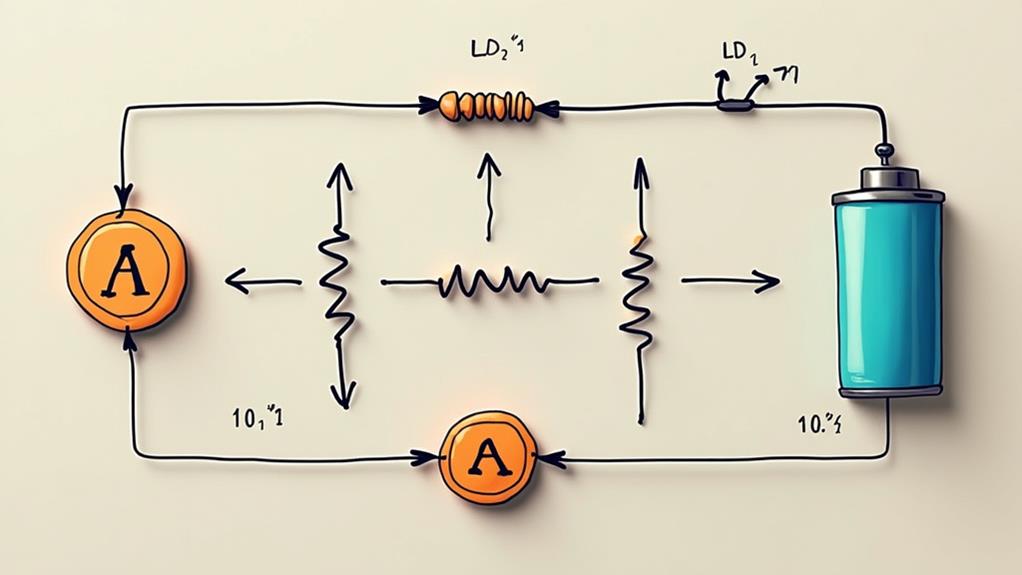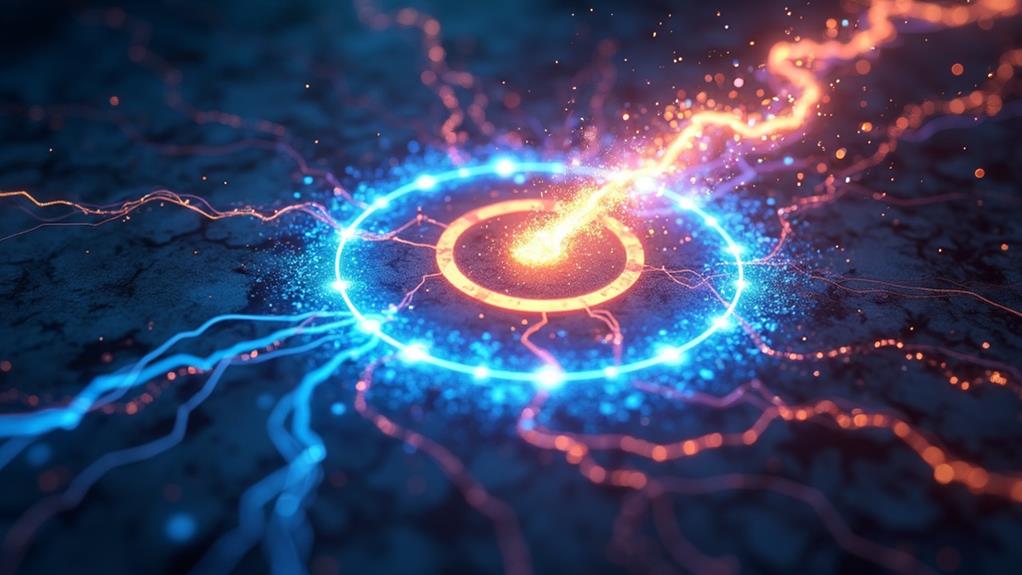What Are the Three Types of Electrical Power?

Electrical power isn't just a single entity; it comprises three distinct types: Active Power (P), Reactive Power (Q), and Apparent Power (S).
- Active Power (P): This is the actual energy that performs useful work in an electrical circuit, such as lighting a bulb or powering a motor.
- Reactive Power (Q): This is the energy that oscillates between the source and load, crucial for maintaining voltage levels in the system.
- Apparent Power (S): This is the combined measure of both Active and Reactive Power, providing a comprehensive view of the total power in the system.
Understanding these types is essential for grasping how electrical systems function and why they operate the way they do. This knowledge is foundational for real-world applications, from household appliances to industrial machinery.
Definition of Electrical Power

Understanding electrical power is crucial for managing and consuming energy in electrical systems. Electrical power is defined as the rate at which electrical energy is consumed or dissipated in a circuit, calculable by the formula P = V × I, where P represents power, V is voltage, and I is current. The SI unit for electrical power is the watt (W), equivalent to one joule per second (J/s). Power may also be expressed in milliwatts (mW) or kilowatts (kW), depending on the scale.
In Alternating Current (AC) systems, electrical power is categorized into three types. First, Active Power (P) is the actual power consumed by devices to perform work. Second, Reactive Power (Q) oscillates between the source and load, not performing real work but essential for maintaining voltage levels. Finally, Apparent Power (S) is the combination of Active and Reactive Power, representing the total power in an AC circuit.
Understanding these classifications allows for better analysis of energy transfer and optimization of efficiency in various applications. By comprehending the definition of power, one can manage and utilize electrical energy more effectively.
Importance of Electrical Power
Understanding the importance of electrical power helps improve energy transfer efficiency and optimize power usage. By focusing on active, reactive, and apparent power, energy consumption can be better managed, reducing costs. This knowledge enhances the performance of electrical systems and contributes to economic growth and development.
Energy Transfer Efficiency
Energy transfer efficiency in electrical systems is fundamentally influenced by the interplay between Active Power and Reactive Power. Active Power (P), measured in Watts, performs tangible work, such as lighting bulbs or driving motors. Reactive Power (Q), measured in Volt-Amperes Reactive (VAR), is essential for maintaining voltage levels vital for the reliable operation of AC systems.
The Power Factor (PF), calculated as PF = P/S (where S is Apparent Power), is a crucial metric that indicates the efficiency of electrical power usage. A Power Factor close to 1 signifies a highly efficient system with minimal energy wastage, which is critical for reducing losses and ensuring efficient energy transfer, particularly in industrial and commercial applications.
Key points to consider for optimizing energy transfer efficiency in electrical systems are:
- Maximizing Active Power: Ensures more useful work is performed.
- Managing Reactive Power Effectively: Helps stabilize voltage levels.
- Maintaining an Ideal Power Factor: Reduces energy loss and enhances efficiency.
Power Usage Optimization
Optimizing power usage in electrical systems begins with managing energy transfer efficiency. Understanding the three types of electrical power—Active Power (P), Reactive Power (Q), and Apparent Power (S)—is crucial. Active Power, measured in Watts, represents the actual power consumed to perform useful work and is essential for calculating energy costs and enhancing efficiency. Reactive Power, measured in Volt-Amperes Reactive (VAR), does not perform useful work but is necessary for maintaining voltage levels and ensuring the stability of the electrical system. Efficient management of Reactive Power is vital to minimize energy losses.
Apparent Power, measured in Volt-Amperes (VA), is the vector sum of Active and Reactive Power. Understanding the relationship between these types of power is key to evaluating the overall performance of your system. Optimizing power usage involves improving the Power Factor, which is the ratio of Active Power to Apparent Power. A higher Power Factor indicates more efficient utilization of electrical power.
Direct Current (DC) Power

Direct Current (DC) power is characterized by its consistent voltage, making it ideal for electronic devices and circuits. Sources such as batteries, solar panels, and fuel cells generate DC, providing a stable flow of electric charge. DC power is used in various applications, including charging batteries, powering electric motors in vehicles, and operating robotics.
DC Power Sources
Direct Current (DC) power is characterized by its ability to maintain a constant flow of electric charge in one direction, making it ideal for applications requiring stable voltage levels. Various sources convert different forms of energy into DC electrical energy to meet diverse needs.
- Batteries: As the most common DC power sources, batteries provide reliable voltage and current for portable devices such as smartphones and laptops. The power consumption of these devices can be calculated using the formula \( P = V imes I \), where \( P \) is power in watts, \( V \) is voltage in volts, and \( I \) is current in amperes.
- Solar Panels: These devices convert sunlight directly into electrical energy, providing a sustainable DC power source. They are ideal for applications like solar-powered calculators and off-grid homes.
- Fuel Cells: By generating electrical energy through chemical reactions, fuel cells serve specialized applications such as electric vehicles and backup power systems, offering a consistent DC power supply.
DC power is widely used in electronic devices, including laptops, smartphones, and LED lighting. Its stable and efficient nature ensures smooth operation of these gadgets without interruptions.
Consistent Voltage Characteristics
Understanding DC power sources is essential for exploring their consistent voltage characteristics. Direct Current (DC) power is characterized by a constant voltage and current flowing in one direction, making it highly stable and predictable. This stability is crucial for many electronic applications where voltage fluctuations could cause damage or erratic behavior.
DC power is commonly generated by batteries, solar panels, and fuel cells. These sources provide a reliable, steady energy supply, ensuring that devices requiring consistent voltage levels, such as computers and LEDs, function effectively. In a DC circuit, the relationship between power, voltage, and current is determined using the formula P = V × I, where P represents power in watts, V represents voltage in volts, and I represents current in amperes.
Because DC power maintains a unidirectional flow, unlike Alternating Current (AC) which changes direction periodically, it is vital for applications like battery charging and powering sensitive electronic components. In purely resistive DC circuits, the power factor is always 1, indicating that all supplied power is effectively utilized without any reactive power components. This efficiency highlights the importance of DC power in delivering consistent and reliable electrical performance across diverse applications.
Applications of DC
DC power is crucial for a wide range of modern electronic devices, providing stable and consistent voltage for efficient operation. It powers smartphones, laptops, and LED lighting, among other gadgets, making it indispensable in everyday life.
One key application of DC power is in rechargeable batteries, which convert stored chemical energy into electrical energy to drive devices like portable electronics and electric vehicles. This technology is integral to the functionality of everything from mobile phones to electric cars.
Another significant application is in solar panels. These panels generate DC power from sunlight, which can be used directly to charge batteries or converted to AC power via inverters for household electricity. Solar panels enable the harnessing of renewable energy, promoting sustainability in residential and commercial settings.
In the realm of telecommunications, DC power is essential for low-voltage applications, providing efficient power to network equipment and data centers with minimal energy loss. This ensures the reliability and smooth operation of internet and communication systems.
Key Applications of DC Power:
- Rechargeable Batteries: Power electric vehicles and portable electronics.
- Solar Panels: Generate renewable energy for homes and devices.
- Telecommunications: Power network equipment and data centers efficiently.
DC power's versatility and efficiency make it a cornerstone in both consumer and industrial applications.
Alternating Current (AC) Power
Alternating Current (AC) power is fundamental to modern electrical power distribution systems. Unlike Direct Current (DC), AC power periodically reverses direction, typically in a sinusoidal pattern. This characteristic allows for efficient transformation to different voltage levels using transformers, which is crucial for long-distance transmission and minimizing energy losses.
In AC systems, you encounter three main types of power: Active Power, Reactive Power, and Apparent Power. Active Power (P) is the actual power consumed by devices to perform useful work. Reactive Power (Q) oscillates between the source and the load, contributing no useful work but is necessary for maintaining voltage levels. Apparent Power (S) combines both Active and Reactive Power and is measured in Volt-Amperes (VA). The mathematical relationship among these is \( S = P + jQ \), with \( j \) representing the imaginary unit.
Another significant aspect of AC power systems is the power factor (PF), calculated as \( PF = rac{P}{S} \). The power factor indicates how efficiently electrical power is being used. A power factor closer to 1 signifies minimal energy wastage, ensuring that most of the supplied power is converted into useful work.
This foundational understanding of AC power and its components is crucial for effective design and operation of electrical power systems, ensuring energy efficiency and system reliability.
Active Power (P)

Active Power (P), also known as real power, is the portion of electrical power that is converted into useful work or energy. Measured in watts (W), active power is what actually powers your devices. It can be calculated using the formula \( P = VI \cos(\phi) \), where \( V \) is the voltage, \( I \) is the current, and \( \phi \) is the phase angle between the current and voltage waveforms.
To illustrate the application of active power, consider the following examples:
- Electric Heaters: When an electric heater is turned on, active power heats the coils, providing warmth.
- Incandescent Light Bulbs: Active power causes the filament in the bulb to glow, producing light.
- Resistors: In various circuits, resistors utilize active power to dissipate energy as heat.
The efficiency of an electrical system is often measured by its power factor (PF), which is the ratio of active power to apparent power. A higher power factor indicates more efficient energy use and reduced waste. In an AC circuit, active power is the critical component responsible for performing useful work, as opposed to reactive power, which does not contribute to actual work but will be discussed separately.
Reactive Power (Q)
Ever wondered why some electrical devices need more than just active power to function? That's where reactive power (Q) comes into play. Unlike active power, which performs actual work, reactive power oscillates between the source and the load, primarily in inductive and capacitive circuits. Measured in Volt-Amperes Reactive (VAR), it is essential for maintaining voltage levels in AC power systems, enabling the proper functioning of inductive devices like motors and transformers.
Reactive power is indispensable for creating the magnetic fields required for the operation of these inductive loads. You can calculate it using the formula \( Q = V_{rms} imes I_{rms} imes \sin(\phi) \), where \( \phi \) is the phase angle between the current and voltage. In a balanced three-phase system, the total reactive power can be calculated as \( Q_{total} = \sqrt{3} imes V_{ph} imes I_{ph} imes \sin(\phi) \).
Understanding reactive power is significant because, even though it doesn't perform any direct work, it ensures that your inductive devices operate efficiently within AC power systems. Without it, maintaining the necessary voltage levels and creating the required magnetic fields would be impossible.
Apparent Power (S)

When dealing with AC circuits, understanding Apparent Power (S) is crucial. Apparent power is calculated as the product of the root mean square (RMS) voltage and RMS current in an AC circuit, expressed as \( S = V_{rms} imes I_{rms} \). It is measured in Volt-Amperes (VA) and represents the total power in the circuit, encompassing both active power and reactive power. Although apparent power provides a comprehensive view of the total power present, it does not indicate how much of that power is effectively usable.
To better understand this concept, consider the power triangle, which illustrates the relationship between apparent power (S), active power (P), and reactive power (Q):
- Apparent Power (S): The hypotenuse of the triangle, representing the total power in the system.
- Active Power (P): The adjacent side, indicating the power that performs useful work, measured in Watts (W).
- Reactive Power (Q): The opposite side, representing the power stored and released by reactive components, measured in Volt-Amperes Reactive (VAR).
Grasping the concept of apparent power is essential for designing and managing electrical systems. It aids in determining the necessary specifications for transformers and generators to efficiently handle total power loads. While apparent power includes energy that does not perform useful work, being aware of it ensures that your electrical system can support both active and reactive power demands effectively.
Power Factor Significance
Understanding the importance of power factor is crucial for optimizing electrical systems. The power factor (PF) measures how effectively electrical power is converted into useful work. Defined as the ratio of active power (P) to apparent power (S), it is expressed as PF = P/S. A power factor close to 1 indicates high efficiency, while a low power factor signals that a significant portion of electricity isn't being utilized effectively, resulting in increased energy consumption and costs.
Industries often face penalties from utility companies for maintaining a low power factor, which hikes operational costs and reduces overall system efficiency. Improving power factor typically involves using capacitors or inductors in the circuit to offset the effects of inductive loads, which usually cause lagging power factors.
Regular monitoring and correction of the power factor are vital for optimizing energy consumption and minimizing losses in electrical systems. Maintaining a high power factor not only saves on energy costs but also ensures that electrical systems operate more efficiently and reliably.
Applications of DC Power

Direct current (DC) power is crucial in modern technology and various applications, underpinning many systems and devices that enhance and sustain daily life. Below are some key areas where DC power has a significant impact:
- Electronic Devices: Devices such as smartphones, laptops, and digital cameras rely on DC power for their operation. A stable and constant voltage is essential for these devices to function reliably and efficiently.
- Renewable Energy: Solar panels generate DC power, which can be stored in batteries for later use. This capability is fundamental to renewable energy systems, allowing solar energy to be harnessed and utilized even when sunlight is not available.
- Electric Vehicles (EVs): DC power is vital for charging batteries and powering the electric motors in EVs. This application is pivotal in the transition to sustainable transportation, reducing dependence on fossil fuels.
Additionally, DC power is essential for telecommunications infrastructure, powering equipment such as cell towers and data centers. Industrial automation systems also depend on DC power for control circuits and actuators, ensuring precise and reliable operations.
DC power's widespread application underscores its importance in advancing technology and sustainability across various sectors.
Applications of AC Power
Alternating current (AC) power is the backbone of modern electrical systems, providing the energy necessary for everyday functions in homes, businesses, and industrial applications. It is essential for lighting, heating, and powering a wide array of appliances. One of the major advantages of AC power is its ability to be easily transformed to different voltage levels, which makes it the ideal choice for both residential and commercial buildings. AC power is generated at power plants and distributed through an extensive electrical grid, enabling efficient long-distance transmission with minimal energy loss.
In residential settings, AC power typically operates at standard frequencies of 50 Hz or 60 Hz, ensuring the synchronized operation of various electrical devices. This flexibility allows for the conversion of AC power into different forms, such as single-phase for smaller loads like household appliances and three-phase for larger industrial applications, thereby improving efficiency in power distribution and supporting a broad range of electrical components.
Furthermore, AC systems are particularly well-suited for inductive loads such as motors and transformers, which are vital for numerous industrial processes and machinery operations. Whether you're running a washing machine or a factory, AC power ensures that your electrical circuits are reliable and efficient, making it indispensable across a multitude of applications.




